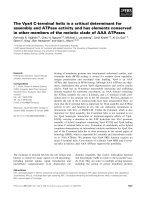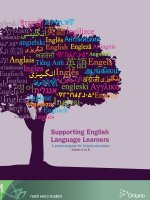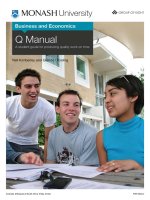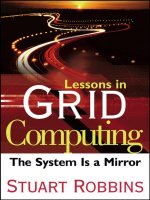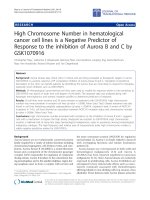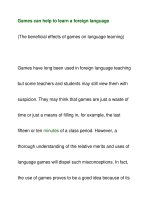In charge supplementary resources
Bạn đang xem bản rút gọn của tài liệu. Xem và tải ngay bản đầy đủ của tài liệu tại đây (1.5 MB, 147 trang )
On Your Mark - In Contact - On Target - In Charge
series
visit Obama-OMama.blogspot.com
for more eBooks and materials
IN CHARGE 1
GRAMMAR / Tenses
INSTRUCTIONS
FOR THE
TEACHER
This grammar exercise is a supplement to the exercises of In Charge 1, Unit 1, pages 6
through 9.
1. Distribute the Student Worksheet to your students. Have them fill in the blanks with
the correct form of the verb in parentheses.
2. When the students finish the worksheet, have them discuss their answers with a
partner. Alternatively, have them do the worksheet in pairs, discussing their choices
as they go along. Then have them work with another pair to compare answers.
3. Go over the answers as a class. Note that some verb forms can be written in two
different ways, depending on the student’s intended focus. For example:
Some studies (find) ___________ that spicy foods …
(9)
Answer: “have found” or “are finding”
4. Note that an answer key is provided for the Student Worksheet.
Optional:
In preparation for the Grammar Worksheet, have your students discuss the following
questions. Prompt them to use the simple present and present perfect progressive tenses
in their responses.
1.
2.
3.
4.
5.
How spicy do you like your foods?
Which spicy foods do you like, if any, and how often do you eat them?
If you don’t like spicy foods, why not?
Do you drink carbonated drinks?
What are you having for dinner tonight?
In Charge 1, Unit 1
Copyright © 2003 by Pearson Education, Inc. Permission granted to reproduce for classroom use.
1
IN CHARGE 1
GRAMMAR / Tenses
Student Worksheet
Name: _______________________
Read the following paragraph on spicy foods. Fill in the blanks with the right form of the
verb in parentheses. Use the simple present, present progressive, present perfect, and
present perfect progressive.
have
Do you know what chili peppers and carbonated drinks (have) ___
__ __ in
(1)
common? They both (deliver) ___________ a painful sensation to the brain that
(2)
many people actually like. Scientists now (believe) ___________ that this type of
(3)
painful sensation is as much a part of the flavor of food as taste and smell. Hot,
spicy foods (exist) ___________ in most cultures. However, in the U.S. and
(4)
other Western cultures, for years spicy foods (have) ___________ a reputation
(5)
for causing stomach problems. Western scientists only now (begin) ___________
(6)
to appreciate the health benefits of hot, spicy foods that other cultures (know)
___________ about for ages. The health benefits (seem) ___________ to
(7)
(8)
include an improved digestion, reduced high blood pressure, and protection
against some forms of cancer. And what’s more, some studies
(find) ___________ that spicy foods (speed up) ___________ metabolism,
(9)
(10)
helping people to burn more calories.
In Charge 1, Unit 1
Copyright © 2003 by Pearson Education, Inc. Permission granted to reproduce for classroom use.
2
IN CHARGE 1
GRAMMAR / Tenses
Answer Key
1.
have
2.
deliver
3.
believe
4.
exist
5.
have had
6.
are beginning
7.
have known
8.
seem / have seemed
9.
have found / are finding
10.
speed up
In Charge 1, Unit 1
Copyright © 2003 by Pearson Education, Inc. Permission granted to reproduce for classroom use.
3
IN CHARGE 1
SPEAKING / Comfort Foods
INSTRUCTIONS
FOR THE
TEACHER
These exercises are a supplement to In Charge 1, Unit 1.
Part 1
1. Distribute the Student Worksheet to your students. Discuss the concept of "comfort
foods" with your students. Tell them that comfort foods are foods that make you feel
happy. They are often linked to happy childhood memories and can be considered
food’s equivalent to a hug.
2. Have the students make a list of their own comfort foods. Then separate them into
groups to share and discuss their choices.
Optional:
Have small groups discuss the following questions:
1. What do you think makes a food a comfort food?
2. Talk about a time recently when you needed some comfort food and what you chose
to eat. How did it make you feel?
3. What makes your comfort foods particularly appealing to you? Is it the taste, the
texture, availability and convenience, or a memory associated with the food? Explain.
4. Do you think the nature of comfort foods might be different in different cultures?
5. Together create a new comfort food that you think you could market and sell. Tell
your classmates about it and take a vote to decide whose new comfort food sounds
the most appealing.
Part 2
1. Distribute the worksheet to the students. Have them conduct a survey. They can
survey another class or survey people they know outside of school. You may choose
to have them do the survey in their native language or in English, depending on
whether you are teaching in an EFL or ESL setting.
2. When the students return to class have them combine their data into one chart per
class or per group. The chart could be written on the board or prepared by one student
per group.
3. If the students are interested, have them repeat the survey to see if there are
differences between age groups. They can survey four people who are in each of the
following age groups: from 12 to 20, from 20 to 40, and over 40. A final alternative
for multicultural classes is to do a survey for differences in comfort food choices
between different culture groups.
In Charge 1, Unit 1
Copyright © 2003 by Pearson Education, Inc. Permission granted to reproduce for classroom use.
4
IN CHARGE 1
SPEAKING / Comfort Foods
Student Worksheet
Name: _______________________
Part 1
A. The following is a list of some common comfort foods in America. Put a check next to
the ones you have eaten or are familiar with. Circle any that could be comfort foods for
you.
pudding
macaroni and cheese
chicken noodle soup
mashed potatoes
apple pie
chocolate chip cookies
ice cream
corned beef and cabbage
quesadillas
chocolate
strawberries and whipped cream
lasagna
pancakes and maple syrup
bagels and cream cheese
B. Make a list of your three favorite comfort foods.
___________________
___________________
___________________
C. In groups of three to five, compare and discuss your choices.
In Charge 1, Unit 1
Copyright © 2003 by Pearson Education, Inc. Permission granted to reproduce for classroom use.
5
IN CHARGE 1
Part 2
Do a survey outside of class.
A. Ask at least four men and four women what their three favorite comfort foods are.
Bring this information back to class.
Men:
1. ____________________ ____________________ ___________________
2. ____________________ ____________________ ____________________
3. ____________________ ____________________ ____________________
4. ____________________ ____________________ ____________________
Women:
1. ____________________ ____________________ ____________________
2. ____________________ ____________________ ____________________
3. ____________________ ____________________ ____________________
4. ____________________ ____________________ ____________________
B. Compile your information in the chart below. Include only foods mentioned more than
one time. In the left-hand column, write the number of times the food was chosen.
Number
of times
MEN
WOMEN
C. Discuss your findings. Is there any difference between what women and men choose
as comfort foods? If so, what is the nature of the difference?
In Charge 1, Unit 1
Copyright © 2003 by Pearson Education, Inc. Permission granted to reproduce for classroom use.
6
IN CHARGE 1
VOCABULARY
INSTRUCTIONS
FOR THE
TEACHER
These exercises are a supplement to Unit 1 of In Charge 1.
Part 1
Distribute the Student Worksheet to your students. Have them fill out the word formation
chart. They should use a monolingual dictionary as needed. Point out that they may find a
different form of the word in the dictionary. Depending on how the dictionary is
organized, other forms may appear somewhere in the definition or as a separate
headword. If the students are using different dictionaries, it might be worthwhile to look
at the introduction to see how each dictionary works in this regard. Note that an answer
key is provided for Part 1.
Part 2
Have your students write 10 sentences with blanks for the vocabulary words from the
chart. Tell them not to write their sentences in the same order as in the chart. You may
want to circulate to check the accuracy of the sentences and to help with individual
vocabulary and spelling questions.
Part 3
1. Have your students exchange papers and then fill in the blanks.
2. When they are have finished, have them return the papers to the pair who wrote the
sentences. They will grade the 10 items. Tell them that 10 points will be awarded for
every correct answer, and 5 points will be awarded if the word choice is correct but
the word form is not.
3. Leave time for the students to go over the papers together.
You may choose to have students do Parts 1 and 2 individually for homework.
In Charge 1, Unit 1
Copyright © 2003 by Pearson Education, Inc. Permission granted to reproduce for classroom use.
7
IN CHARGE 1
VOCABULARY
Student Worksheet
Name: _______________________
Part 1
Work in pairs. Complete the word formation chart below. Use a dictionary to help you
find the word parts you do not know. The boxes with Xs indicate that the word does not
exist in that form.
Noun
Verb
Adjective
Adverb
blend
desirable
desire
delight
range
trace
resemble
aromatic
linger
smuggler
prized
compound
secretion
In Charge 1, Unit 1
Copyright © 2003 by Pearson Education, Inc. Permission granted to reproduce for classroom use.
8
IN CHARGE 1
Part 2
With your partner, write 10 statements or questions with blanks for the vocabulary words.
Use any form of the word. For example:
Colombian coffee is very _________. (Answer: aromatic)
Part 3
Exchange papers with another pair and complete the sentences. Then return your papers
to the pair that wrote the sentences. Check the answers.
In Charge 1, Unit 1
Copyright © 2003 by Pearson Education, Inc. Permission granted to reproduce for classroom use.
9
IN CHARGE 1
VOCABULARY
Answer Key
Part 1
Noun
Verb
Adjective
Adverb
blend
blend
desire
desire
desirable
desirably
delight
delight
delightful
delightfully
range
Range
trace
trace
resemblance
resemble
aroma
traceable /
traceless / traced
aromatic
smuggler
smuggle
prize
prize
prized
compound
compound
compoundable
secretion
secrete
aromatically
In Charge 1, Unit 1
Copyright © 2003 by Pearson Education, Inc. Permission granted to reproduce for classroom use.
10
IN CHARGE 1
GRAMMAR / Tenses (2)
INSTRUCTIONS
FOR THE
TEACHER
This exercise is a supplement to the exercises of In Charge 1, Unit 2, pages 18 through
21.
1. Distribute the Student Worksheet to your students. Have them complete the interview
with the correct verb forms.
2. Ask the students to categorize the verb phrases by tense: simple past, past
progressive, and past perfect.
3. Separate the students into groups and ask them to discuss the reasons for their
choices.
4. Go over the answers as a group.
5. Note that an answer key is provided for the Student Worksheet.
In Charge 1, Unit 2
Copyright © 2003 by Pearson Education, Inc. Permission granted to reproduce for classroom use.
1
IN CHARGE 1
GRAMMAR / Tenses (2)
Student Worksheet
Name: _______________________
A. Read the following paragraph and circle the correct verb phrases.
Interviewer: We’re talking with Pete Tucker, leader of the rock band Macaroons, about
his first experience playing music for money.
Pete: Well, I guess it when I was just 16 years old. I (was waiting / waited) on tables in
(1)
a restaurant where a band played every weekend. One evening, the band
(had called / called) to say they were stuck in a snowstorm. The restaurant manager was
(2)
extremely upset by this. It was while he (had tried / was trying) to figure out what to do
(3)
that I suddenly (was realizing / realized) my lucky break (had arrived / arrived).
(4)
(5)
I (was running / ran) to get my guitar from my car, jumped on stage, and started
(6)
playing a song I (had just finished / just finished) writing the night before.
(7)
Where I (found / was finding) the courage to do that, I’ll never know. Everyone in
(8)
the restaurant (stopped / had stopped) talking the whole time I (sang / was singing).
(9)
(10)
No one (left / had left) the restaurant until after (I had finished / I finished).
(11)
(12)
As I (had put / was putting) away my guitar, my boss handed me a check and said,
(13)
“I guess (we’ll be looking / we look) for a new waiter now.”
(14)
Interviewer: So, I guess you could say you owe your career as a musician to a
bad snowstorm!
Pete: I guess so!
In Charge 1, Unit 2
Copyright © 2003 by Pearson Education, Inc. Permission granted to reproduce for classroom use.
2
IN CHARGE 1
B. Complete the table with the verb phrases from the paragraph.
Simple Past
Past Progressive
Past Perfect
called
C. Work in groups. Compare answers and discuss the reasons for your choices.
In Charge 1, Unit 2
Copyright © 2003 by Pearson Education, Inc. Permission granted to reproduce for classroom use.
3
IN CHARGE 1
GRAMMAR / Tenses (2)
Answer Key
A.
1. was waiting
2. called
3. was trying
4. realized
5. had arrived
6. ran
7. had just finished
8. found
9. stopped
10. was singing
11. left
12. I had finished
13. was putting
14. we’ll be looking
B.
Simple Past
called
realized
ran
found
stopped
left
Past Progressive
was waiting
was trying
was singing
was putting
Past Perfect
had arrived
had finished
I had finished
In Charge 1, Unit 2
Copyright © 2003 by Pearson Education, Inc. Permission granted to reproduce for classroom use.
4
IN CHARGE 1
SPEAKING / Milestones
INSTRUCTIONS
FOR THE
TEACHER
These exercises are a supplement to In Charge 1, Unit 2.
1. Distribute the Student Worksheet to your students. Discuss the term "milestones."
Milestones are the important events that mark times of development or growth in a
person’s life.
2. For Part 1, have the students make a list of typical milestones for people of various
age groups. They can do this individually or in pairs.
3. For Part 2, separate the students into groups to compare and discuss the significance
of the milestones they collected in the chart.
4. After the discussion, have each student share one or two important personal
milestones with the group.
In Charge 1, Unit 2
Copyright © 2003 by Pearson Education, Inc. Permission granted to reproduce for classroom use.
5
IN CHARGE 1
SPEAKING / Milestones
Student Worksheet
Name: _______________________
Part 1
Make a list of typical milestones for each age group.
0–5
5 – 12
12 – 18
18 – 35
35 – …
learning to
walk
Part 2
Work in small groups and compare your milestones. Discuss the significance of each one.
Talk about two important milestones in your life. Why were they important to you? What
were you doing at the time? What had you been doing previously?
In Charge 1, Unit 2
Copyright © 2003 by Pearson Education, Inc. Permission granted to reproduce for classroom use.
6
IN CHARGE 1
VOCABULARY
INSTRUCTIONS
FOR THE
TEACHER
These exercises are a supplement to In Charge 1, Unit 2.
Part 1
1. Distribute the Student Worksheet. Have students match the vocabulary words with
their antonyms. They can use a monolingual dictionary, if necessary.
2. Have the students partner with a classmate. Ask them to compare answers and discuss
the meanings of the words, finding synonyms where possible.
3. Note that you may choose to have students do Part 1 A individually for homework.
4. An answer key is provided for the Student Worksheet.
Part 2 Story Game
1. The purpose of the game is to use all of the vocabulary words in a story.
2. Divide the students up into teams of four to five.
3. Each student in the team writes one sentence using one of the vocabulary words as
quickly as possible, and then passes the paper on to the next student until all the
words have been used. The team that finishes first reads their story out loud to the
class. If time permits, have the other groups read their stories as well.
In Charge 1, Unit 2
Copyright © 2003 by Pearson Education, Inc. Permission granted to reproduce for classroom use.
7
IN CHARGE 1
VOCABULARY
Student Worksheet
Name: _______________________
Part 1
A. Match the following words with their antonyms.
1. ____ straightforward
2. ____ start-up
3. __f_ catchy
4. ____ tall tales
5. ____ counterparts
6. ____ fidget
7. ____ knack
8. ____ immerse oneself
9. ____ insight
10. ____ soar
11. ____ by-the-book
12. ____ lofty
a.
b.
c.
d.
e.
f.
g.
h.
i.
j.
k.
l.
m.
opposites
humble
complicated
finish
inability
boring
dishonest
crawl
remain disinterested
true stories
stay still
lack of understanding
wiggle
B. Work in pairs. Discuss the meaning of each word and try to find a synonym, where
possible.
Part 2 Story Game
Get into teams of four or five students. Count off so that each student has a number
starting with the number one. Student number 1, begin writing a story by writing a
sentence using one of the vocabulary words as quickly as you can. Then hand the paper
to student number two to continue the story using another vocabulary word. Continue in
this manner until one team has used up all the words. The team that finishes first reads
their story to the class. The other teams read their stories to each other.
In Charge 1, Unit 2
Copyright © 2003 by Pearson Education, Inc. Permission granted to reproduce for classroom use.
8
IN CHARGE 1
VOCABULARY
Answer Key
Part 1 A.
1. c
2. d
3. f
4. j
5. a
6. k
7. e
8. i
9. l
10. h
11. g
12. b
In Charge 1, Unit 2
Copyright © 2003 by Pearson Education, Inc. Permission granted to reproduce for classroom use.
9
IN CHARGE 1
GRAMMAR / Tenses (3)
INSTRUCTIONS
FOR THE
TEACHER
This exercise is a supplement to the exercises of In Charge 1, Unit 3, pages 29 to 32.
1. Distribute the Student Worksheet to your students. Explain to them that the point of
the exercise is to imagine that it is the 1970s, and they are discussing the future of
movie theaters. Have them complete the sentences using the appropriate future verb
forms and phrases from the list (or phrases of their own).
2. Then have the students work in pairs to compare their answers.
3. Review the answers as a class.
4. Because students’ answers will vary, there is no answer key for this worksheet.
In Charge 1, Unit 3
Copyright © 2003 by Pearson Education, Inc. Permission granted to reproduce for classroom use.
1
IN CHARGE 1
GRAMMAR / Tenses (3)
Student Worksheet
Name: _______________________
A. North American movie theaters have changed enormously in the last thirty or so
years. Imagine it is the 1970s, and you are discussing the future of movie theaters.
Complete these sentences using the appropriate future verb form and phrases from the
list. You can use your own phrases as well.
Movie theaters in the 21st century
¾
¾
¾
¾
¾
¾
bigger and more comfortable seats
drink holders attached to seats
stadium seats so everyone can see
theaters with multiple screens
better sound systems
increased ticket prices
1. I know that movie theaters of the future will have better sound systems.
________________________________________________________________
2. It’s hard to believe that movie theaters _______________________________
________________________________________________________________
3. More movies are made every year. Based on that fact, in thirty years, movie
theaters _________________________________________________________
________________________________________________________________
4. Some movie theater companies are already planning movie theaters with more
screens. I read that next year Movie Plex _______________________________
________________________________________________________________
In Charge 1, Unit 3
Copyright © 2003 by Pearson Education, Inc. Permission granted to reproduce for classroom use.
2
IN CHARGE 1
5. Cinema Scope reported that in twenty years all their movie theater seats
________________________________________________________________
________________________________________________________________
6. I wonder if the price of admission to movies ___________________________
________________________________________________________________
7. In my opinion, the tickets ___________________ because _______________
________________________________________________________________
8. I don’t agree that tickets _____________________ because ______________
________________________________________________________________
9. If movie theaters continue to improve in all these ways, I bet that __________
________________________________________________________________
10. All this talk of movie theaters is making me want to go to a movie tonight.
Let’s ____________________________________________________________
________________________________________________________________
11. Good idea. Where______________________________ and when
_______________________________________________________________?
B. Work in pairs. Compare your answers and discuss the reasons for your choices.
In Charge 1, Unit 3
Copyright © 2003 by Pearson Education, Inc. Permission granted to reproduce for classroom use.
3
IN CHARGE 1
SPEAKING / The Future of Entertainment
INSTRUCTIONS
FOR THE
TEACHER
These exercises are a supplement to In Charge 1, Unit 3.
1. Distribute the Student Worksheet to your students. Have them read the list of
potential developments in movie theaters of the future.
2. In Part A, explain to your students that they will now rate the list of developments
according to the likelihood of their actually happening.
3. In Part B, the students work in groups to compare and justify their ratings, discuss
their own feelings about them, and come up with some other possible developments.
Note that students could do the ratings for homework and discuss them in class.
Optional:
You can also have the students work in small groups to list possible developments in
television and radio. Tell the groups to make some of their developments likely and
some unlikely. Then have the groups exchange and rate each other's lists. The exercise
can be concluded with a group discussion.
In Charge 1, Unit 3
Copyright © 2003 by Pearson Education, Inc. Permission granted to reproduce for classroom use.
4

